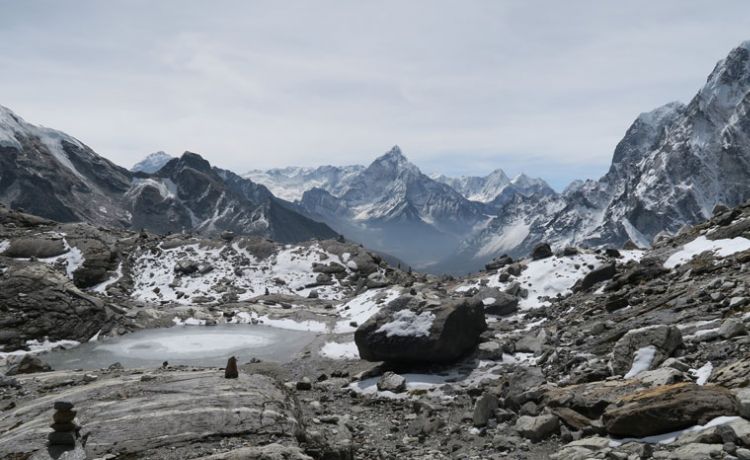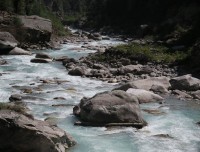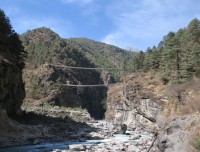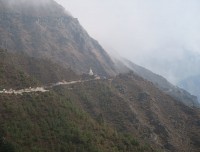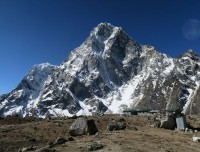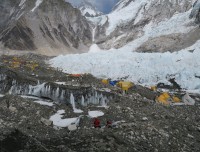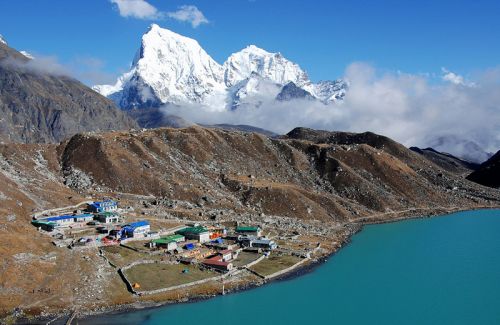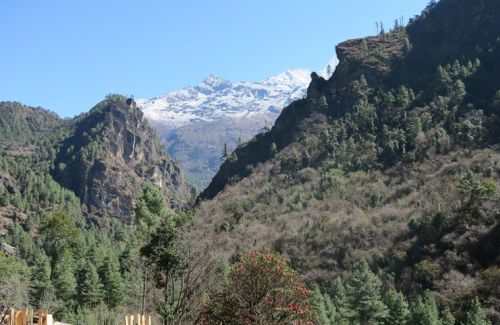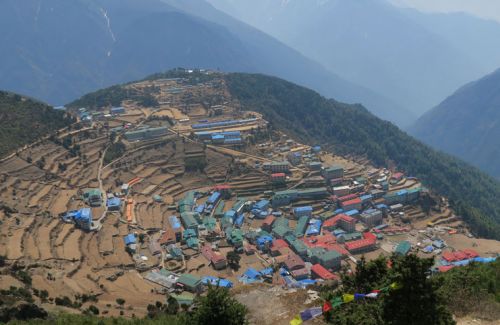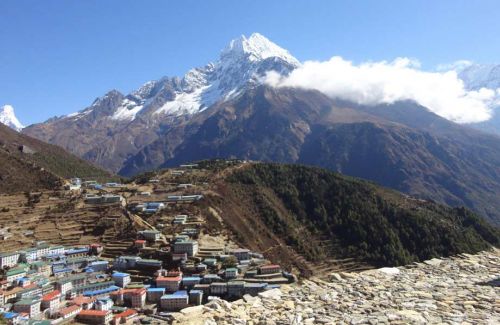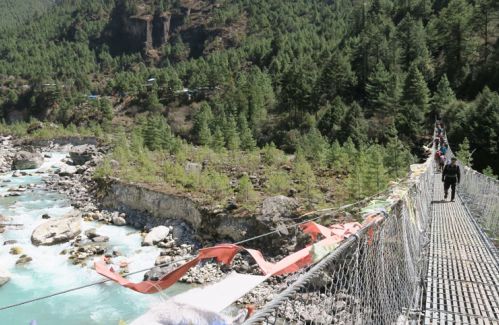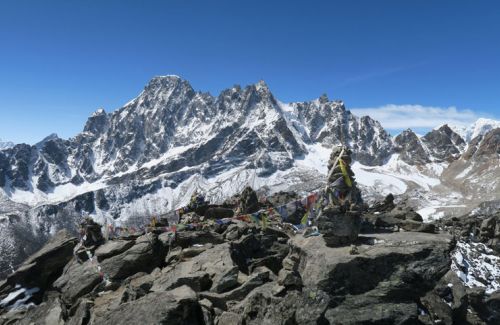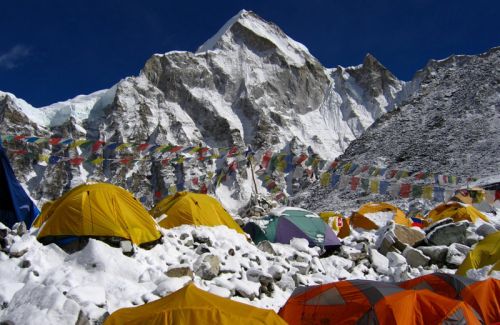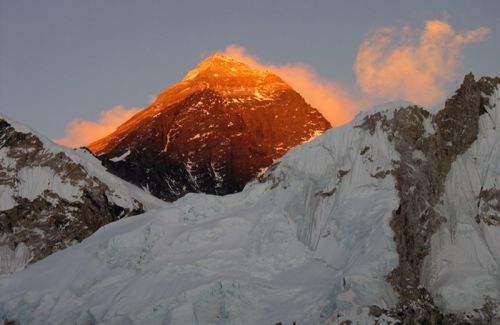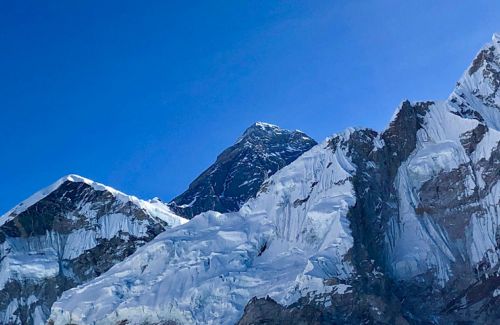Jiri to Everest Base Camp Trek
- Duration21 Days
- Max. Altitude5,545 m
- Starts FromUSD 1800
Destination:Nepal
Trip Grade:Strenuous (****)
Meals:Breakfast + Lunch + Dinner
Transportation:Private Vehicle / Aeroplane
Accommodation:Lodge
Trek Starts From:Shivalaya
Show AllJiri to Everest Base Camp Trek is the classic trekking route which combines countryside of hilly region then to the high alpine Himalayan region of Khumbu. Trek Jiri to Everest Base Camp was first explored by the first Everest summiteers Sir Edmund Hillary and Tenzing Norgay. This is the areas where Hindu Brahmin settlement of Jiri connects to the high altitude Sherpa land. Not only this one, it is the trekking which offers lowland panoramic rural culture, norms and value, way of living to high altitude Sherpa Himalayan culture. The trekking to the top of Kalapatthar and the scenic view in the periphery of Everest with its lower peaks is beyond imagination.
This is the perfect trekking to the beginners who has not done this in high altitude region. The trek provides an opportunity to get proper acclimatized. Once you directly fly from Kathmandu, which is 1350 m high from the sea level and adjust with the altitude of 2800 m at Lukla or 2652 m at Phakding may have problem for the first time trekker in the Himalayas of Nepal. So, Jiri to Everest Base Camp Trekking is suitable trekking in many reasons.
The Jiri to Everest Base Camp Trek begins from Kathmandu with scenic drive to Shivalaya which takes about 8 hours by bus. Then we begin our trekking from Shivalaya. It is the trekking with foothills of hilly regions through peaceful hamlets, streams, forests and rivulets, goes to link with high altitude cliff, craggy mountain ridges.
Trip Highlights
- Full day sightseeing in UNESCO World Heritage Sites in Kathmandu
- Scenic flight over the Himalayas from Lukla to Kathmandu
- Interaction with mid hill living people from Shivalaya to High hill people
- Pristine natural setting, panoramic landscape view
- Quiet village life and their ritual activities
- Sufficient time for acclimatization
- Great mountain view and sunrise from Kalapatthar
- Classic route explored by the Sir Edmund Hillary and Tenzing Norgey
- Tengboche Monastery, the high altitude monastery of Khumbu reason
- Sherpa culture and Himalayan life style
Day to Day Itinerary
Day 01:Arrival in Kathmandu airport (1350 m), Transfer to hotel. Overnight at Hotel
Day 02:Pre-Trip meeting and Kathmandu sightseeing. O/N at Hotel
Day 03:Drive from Kathmandu to Shivalaya (1838 m), 8 hrs, O/N at Guest House
Day 04:Trek from Shivalaya to Bhandar (2190 m), 6 hrs, O/N at Guest House
Day 05:Trek from Bhandar to Sete, 6-7 hrs (2645 m), O/N at Guest House
Day 06:Trek from Sete to Junibenshi (2675 m), 6-7 hrs, O/N at Guest House
Day 07:Trek from Junibenshi to Nunthala (2440 m), 6-7 hrs, O/N at Guest House
Day 08:Trek from Nunthala to Kharikhola (2020 m), 6-7 hrs, O/N at Guest House
Day 09:Trek from Kharikhola to Puiyan (2700 m), 6-7 hhrs, O/N at Guest House
Day 10:Trek from Puiyan to Phakding (2652 m), 6-7 hrs, O/N at Guest House
Day 11:Trek from Phakding to Namche (3440 m), 6-7 hrs, O/N at Guest House
Day 12:Acclimatization day at Namche. O/N at Guest House
Day 13:Trek from Namche to Tengboche (3870 m), 6-7 hrs, O/N at Guest House
Day 14:Trek from Tengboche to Dingboche (4317 m), 6-7 hrs, O/N at Guest House
Day 15:Trek from Dingboche to Lobuche (4940 m), 6-7 hrs, O/N at Guest House
Day 16:Trek from Lobuche to Everest Base Camp (5365 m), back to Gorakshep (5180 m), 8 hrs,O/N at Lodge
Day 17:Trek from Gorakshep to Pangboche (3860 m), 6-7 hrs, O/N at Guest House
Day 18:Trek from Pangboche to Namche (3440 m), 6-7 hrs, O/N at Guest House
Day 19:Trek from Namche to Lukla (2800 m), 5-6 hrs, O/N at Guest House
Day 20:Fly from Lukla to Kathmandu, Farewell Dinner, O/N at Hotel
Day 21:Departure to International Airport
Cost Include
- Airport Picks up and Drops off by private tourist vehicle
- Guided city tour by private tourist vehicle
- A full day sightseeing at UNESCO World Heritage Sites in Kathmandu
- A government licensed holder city Tour Guide
- 3 nights in Kathmandu in twin sharing basis 2-3 star hotels with Breakfast
- Flight from Lukla to Kathmandu
- Lodge to lodge accommodation during the trek
- Full Board meal (Breakfast + Lunch + Dinner) during the trek
- An experienced English Speaking Trekking Guide
- The required number of local staffs and Porter (2 Trekkers = 1 Porter)
- Food, accommodation, salary, insurance, equipment and medicine for guide and porter
- Sagarmatha National Park Entry Permit and TIMS Card for trekking
- Down Jacket, Duffel Bag and Sleeping Bag by Himkala Adventure (If required)
- Farewell Dinner in the typical Nepalese reataurant with Cultural Show
-
Government Taxes, VAT, and Service Charge
Cost Exclude
- Lunch and Dinner in Kathmandu
- Entrance Fees in the World Heritage Sites in Kathmandu
- Nepal Entry Visa Fee
- Your Travel Insurance
- Personal Expenses (Phone Calls, Laundry,Bar bills, Battery Recharge, Bottled or boiled water, Shower etc)
- Personal Trekking Equipments
- Tips for Trekking/Tour staffs, Driver
- Any other expenses which are not mentioned in Cost Includes Section
Detail Itinerary
Day 01Arrival in Kathmandu airport (1350 m), Transfer to hotel. Overnight at HotelThe representative from Himkala Adventure will greet you in the Tribhuvan International Airport, then you will be transfered to hotel in Thamel. After check in you could get refreshed and walk around Thamel in your leisure. Overnight at Hotel in Kathmandu
Day 02Pre-Trip meeting and Kathmandu sightseeing. O/N at Hotel We first meet and brief you about today's sightseeing in World Heritage Sites in Kathmandu. We leave hotel about 9 am and head towards Swoyambhu, a Buddhist stupa perched in the conical shaped hill, 77 m high from the ground level. We walk around the stupa, view Kathmandu Valley and descend towards Kathmandu Durbar Square by our car. We see crowded site with Hindu deities, temples, palaces, most importantly the Kumari House and Basantapur Sqaure. After this, we drive to Boudhnath Stupa, about 8 km far from Kathmandu Durbar Square. It is charming place surrounded by modern houses, with three layers in the shape of Mandala. We can see monks chanting in the Monastery and lighting butter lamps. Then we visit Pashupatinath temple about 2 km far from Boudh Staupa. This is highly revered god by Hindus, and the site is famous for cremation, ritual bathers, sages, and so on. Finally, we drive back to hotel. Overnight at Hotel
Day 03Drive from Kathmandu to Shivalaya (1838 m), 8 hrs, O/N at Guest House The road to Jiri follows Kodari road to Lamosangu, 78 km from kathmandu and turns off there to Jiri, a further 110 km.But, we are driving through rough road to Shivalaya from Jiri. Overnight at Guest House
Day 04Trek from Shivalaya to Bhandar (2190 m), 6 hrs, O/N at Guest House After breakfast, we climb to Sagbadanda, Kosaribas, then to Deurali, a pass at 2705 m. We can descend to Bhandar. There are Budhist Gompas in the Sherpa settlement. We can take short detour to visit Thodung, where there is cheese factory. Overnight at Guest House
Day 05Trek from Bhandar to Sete, 6-7 hrs (2645 m), O/N at Guest House The trail drops down to the Likhu Khola, crosses the river at 1490 m and goes to Kenja. We then take a long ascent to the lamajura Bhanjyang Pass. The first part of the climb is really steep, then it traverses to Sete. Overnight at Guest House
Day 06Trek from Sete to Junibenshi (2675 m), 6-7 hrs, O/N at Guest House Today is the bit more tiring day due to long walk. we gradually climb to Lamajura Bhanjyang. We can take lunch at Goyom. The pass is the highest between Jiri and Namche Bazaar. From the top you descend to Tragdobuk, then to the pretty Sherpa village of Junbenshi. Junbenshi has a monastery. Overnight at Guest House
Day 07Trek from Junibenshi to Nunthala (2440 m), 6-7 hrs, O/N at Guest House The trail climbs to Khurtang,on a ridge and on to Salung. From Salung, the trail descends to the Ringmo Khola. A short climb from Ringmo takes us to Takshindo La, then the trail drops down past the gompa of the same name and on to Nunthala. Overnight at Guest House
Day 08Trek from Nunthala to Kharikhola (2020 m), 6-7 hrs, O/N at Guest House The trail descends to Dudh Koshi and crosses it follow the eastern bank. The trail climbs to Jubing and continues over the ridge to Kharikhola. Overnight at Guest House
Day 09Trek from Kharikhola to Puiyan (2700 m), 6-7 hhrs, O/N at Guest HouseWe wake up early, get breakfast and being active, start our trek. We cross the bridge over the Kharikhola, take the right fork and descend its north bank through the scattered settlement of Kharte. The trail continues to climb through this tributary valley into prickly-leaved oak and rhododendron forest. The ridge crest, Khari La (3,078 m) is 3 hours from Kharikhola We are almost a mile above the Dudh Koshi After passing steep slopes, go through the valley made by the tributary and descend 305 m and cross the tributary after an hour. We still continue to the north side of the valley to reach Puiyan (2,700 m) in half an hour. Overnight at Guest House
Day 10Trek from Puiyan to Phakding (2652 m), 6-7 hrs, O/N at Guest House Continuing the crest of a ridge, Chtok La (2,945 m), leading down to the Dudh Koshi, we can reach the village of Surkhe (2293 m). We can view the Lukla airstrip and the grand view of sacred mountain Khumbila. The trail heads to the north to ChamriKharka. The trail from ChamriKharka passes through pleasant fields and climbs up a small ridge and reaches to Choplung. From Choplung, we head north and arrive at the village of Ghat (2,545 m). We proceed to the east bank through to Phakding (2,652 m). Phakding is half an hour from Choplung and 2 and half an hour from Lukla. Overnight at Guest House
Day 11Trek from Phakding to Namche (3440 m), 6-7 hrs, O/N at Guest House After breakfast, we cross the west bank of Dudh Koshi River, continue the lovely forests of rhododendron and pine, after an hour from Phakding, we reach to Benkar (2,905 m).Again, we keep on going for the journey and cross the Khyangshar Khola (2,773 m) and climb up towards Monjo (2,835 m) about 45 minutes from Benkar.We descend down to the Dudh Koshi River and cross the suspension Bridge to reach Jorsale (2,774 m) in 45 minutes. Then the trail leads straight and relatively steeply upward to the forest. The valley then becomes noticeably narrower, and we finally reach to another bridge, climb about 500 m up to the steep hill. The path leads still further up for about an hour then reaches to Namche Bazaar. Overnight at Guest House
Day 12Acclimatization day at Namche. O/N at Guest House Namche Bazaar is the main,the most populated village of Sherpas in Khumbu region. The town has served everything we need. It’s because of small hydro power, the town has different charm. We can go for short hike to the nearby villages for our acclimatization. Overnight at Guest House
Day 13Trek from Namche to Tengboche (3870 m), 6-7 hrs, O/N at Guest House The trail rises to the saddle to the east where Sagarmatha National Park museum (3520 m) sits. The trail continues through forests of blue pine and rhododendron, passing below the village of Trashinga and through the houses of Levishasa and the forest nursery to the Dudh Koshi River, where there is a small settlement called Phortse Tenga, with several meals. This is two hours from Namche Bazaar. The trail climbs past the prayer wheels through very pleasant forest, with occasional views of Kangtega, to Tengboche (3,870 m), about two hours from the river. What a place for a monastery! Overnight at Guest House
Day 14Trek from Tengboche to Dingboche (4317 m), 6-7 hrs, O/N at Guest House After breakfast, we descend down to Debuche through teh beautiful rhododendron forest, crosses Imja Khola and climbs past Mani stones, then we arrive at Pangboche. From there, we continue our trek to Dingboche. We can see the breathtaking mountain view of AmaDablam. Dingboche is the gateway of Chhukung village and Island Peak climbing. Overnight at Guest House
Day 15Trek from Dingboche to Lobuche (4940 m), 6-7 hrs, O/N at Guest House After breakfast, we gradually climb up to Thukla where we can see memorial park, built in the memory of the Everest Climbers who were passed away while scaling Mt. Everest, on the top after the gentle uphill from Thukla. Finally, we arrive at Lobuche. Overnight at Guest House
Day 16Trek from Lobuche to Everest Base Camp (5365 m), back to Gorakshep (5180 m), 8 hrs,O/N at Lodge After breakfast,we continue our trek to Gorekshep Village. After 3 hours walk in a windy and rocky path, we arrive in Gorakshep. After check in at lodge and having lunch, we continue our ardous trek towards Everest Base Camp and to the Khumbu Ice-fall. During spring season, all the climbers gather in Everest Base Camp with colorful tents .After exploring base camp and its surroundings glacier, we return back to Gorekshep. We can see wonderful view of Mt. Pumori, Mt. Nuptse and other magnificent peaks. Overnight at Guest House
Day 17Trek from Gorakshep to Pangboche (3860 m), 6-7 hrs, O/N at Guest House Early morning, we hike up to Kalapatthar for the most wonderful sunrise views of the Mt.Everest. After climbing couple of hours, we arrive in the famous view point, the top of Kala pathar. Now we have the best view of Mt. Everest, Nuptse, Pumori and Ama Dablam along with the entire mountain views of Khumbu Himalayan range.Spending some time to take photograph here, we hike down to Gorekshep. After breakfast, we descend down to Pangboche. Overnight at Guest House
Day 18Trek from Pangboche to Namche (3440 m), 6-7 hrs, O/N at Guest HouseAfter breakfast, we trek down to Imja River. After crossing Dudh Koshi River and gentle walk we reach Sansa. If we are lucky enough then we can also see mountain goats on the way. Finally, we reach at Namche Bazaar. Overnight at Guest House
Day 19Trek from Namche to Lukla (2800 m), 5-6 hrs, O/N at Guest House This is again the steep walk down to the Dudh Koshi valley and cross the suspension bridge. After this we pass through the forest and Sherpa villages. Upon arrival at Lukla, we spend time relaxing, walking around. Overnight at Guest House
Day 20Fly from Lukla to Kathmandu, Farewell Dinner, O/N at Hotel We fly from Lukla to Kathmandu early morning. Upon your arrival at Tribhuvan International airport, in the domestic terminal, our Himkala representative greets you and takes you to the hotel. You could go for the side trip or do shopping at local market in the cheaper price. In the evening, there is a dinner with typical Nepalese Cultural Show. Overnight at Hotel
Day 21Departure to International AirportWe transfer you to Tribhuvan International Airport, 3 hours before you fly to the next destination. With warm feelings, showing gratitude to you that you joined Himkala Adventure for Jiri to Everest Base Camp Trekking, our represents depart from airport and you go ahead for custom formalities. Namaste with palms together!!!
Trip FAQ
Himkala Adventure would like to answer all the queries about Jiri to Everest Base Camp Trekking for all curious travelers/trekkers in the world. As you are entirely from different geographical location, you could better to know everything about the treks from the beginning i.e. airport pick up till your departure like airport picks up, drops off, accommodation in city, in the trek, guide and porters, safety for the trekking, food and accommodation and some other things that you might face on the way. Hope our endeavor listing these questions answers will help you self informed.
This is simply the outlines of the services we offer but it may differ as per your requirement, number of trekkers. What we go through our conversation, we will manage the means of transportation, hotels in the city, accommodation in the trekking, numbers of porters etc. This is general idea about Jiri to Everest Base Camp Trekking before your trip and you become clearer about the trek. Please feel free to contact us to get more information about the trekking in the Himalayas of Nepal.
1) How is Jiri to Everest Base Camp Trekking in Nepal?
Jiri to Everest Base Camp Trek follows the traditional route taken by the early Everest expeditions and still serves as main artery to the roadless Sagarmatha (Everest) region. Known as the Solu-Khumbu it is the home of the Sherpas.
2) What physical fitness do I need to book this trip?
Every trekking in the Himalayas of Nepal requires the certain level of physical and mental fitness. So, we advise you to be in good physical shape and able to feel comfortable while hiking up and down 7 to 12 miles per day on a trail carrying a day pack of about 10 pounds. Three things could make you confident enough for any trek you would like to do: aerobic, strength and mental.
Aerobic conditioning is important primarily because you will be trekking in Exciting mountain flight over the mountains from Kathmandu - Lukla - Kathmandu
up to 40% less than at sea level. With good aerobic conditioning, you will be able to better metabolize whatever oxygen is available to you. You should plan on doing at least one hour of aerobic 3 /4 times per week for 1 month or more before your arrival in Nepal. Walking, jogging, cycling, hiking on valley floor to ridge line ascents with day back are some of the excellent forms of exercise, so long as you are strengthening leg muscles and building stamina. Speed is not the essence; stamina, confidence and continuity are. Do as much uphill as possible. If you live in flat area, go to the stadium and use the steps with your pack.
3) Is the Jiri to Everest Base Camp Trekking hard or easy?
Classic Everest Trekking can be easy and very exciting if you could walk minimum 5 miles a day and does have aerobic shape (with doctor’s approval). The actual trekking is on mostly ground level with a few sections of hill sides - up and down. You should carry more than a light day pack with your jacket, snacks and water bottle. The important thing is that you should acclimatize yourself with higher altitudes for that you need to maintain your health, should have a large fluid intake and always in slow pace in the Himalayas.
4) Is it dangerous to trek to Jiri to Everest Base Camp Trekking?
Yes or No, Yes, because if we do not take proper precautions of Altitude sickness, there is risk of life. So, one should quite aware what is going on. Next thing we have to be careful with the caravan of yaks, occasionally, there is an incident that trekkers get injured due to rock fall by the flock of yaks or who inadvertently bump them off the trail and go down steep to the hill side. So, be always on the uphill side when the yaks pass by!
5) Do I really need to use guide to Jiri to Everest Base Camp trekking?
You are advised to use Guide so that you could feel safer in the unknown area because the guide can tell you the possible danger as they have guided in this region since long. Most importantly, the Himalayan weather is really unpredictable and the Guide can help you to take proper shelter. Nest advantage to be with Guide is you get more knowledge about local culture and you could have easy access to interact with the local people. In 2014, the Nepal Government clearly has stated that the trekkers should have a guide but still it is not seemed in the practicality.
6) How do I find Himkala Adventure for my pick up at the airport?
Our representative from Himkala Adventure will display a small board (placard) of company or your name outside the airport terminal. You will be driven to the hotel by our tourist vehicle.
7) What sort of accommodation do I get in Kathmandu?
Normally we provide standard rooms with twin sharing accommodations at three star or similar category hotels in Kathmandu including breakfast. Accommodation in these cities can be upgraded as per your request. But some of our packages are sold without accommodation in the city.
8) How are tea house facilities during Jiri to Everest Base Camp Trekking?
Tea House is the combination of guest house, restaurant, and social hang out. Tea houses in Jiri to Everest Base Camp Trekking area are highly professional though they are simple but with neat and clean lodging offering fine views and plain but fresh and hygienic food with friendly atmosphere Most of the Tea Houses have running water facility. Many of them have hot water available for bathing. But we discourage our groups from using water heated by wood as lack of firewood in most villages is a big environmental concern in Nepal.
9) What sort of accommodation do I get in trekking?
Guesthouses/Tea Houses/Lodges provide twin sharing single and double rooms and occasionally a dormitory which is basically clean with a mattress and a quilt or blanket. Our company provides the sleeping bag if needed but we always recommend having your own sleeping equipments. You have to share the room with your group member or sometimes with unknown traveler. The toilet is always outside the room with basic facilities.
10) What sort of foods, water and drinks can I expect in trekking?
The foods in the Himalayas are very simple. There are mostly the family members themselves to cook and serve the meal. They are simply trained but experienced because they have been offering such services for many years in this busy route. The food is hygienic, fresh and delicious. We recommend you to drink mineral water or the boiled or using water purification pills or drops.
Most of the foods are cooked in the kitchen of tea houses. They serve you with different varieties of delicious Nepali and continental dishes. The most popular Nepali food is daal bhat (rice and lentils) with some mixed vegetable curry. Garlic soup is popular as it helps you with acclimatization. You could better be vegetarian in the mountains. All hotels in cities and guesthouses in trekking serve the vegetarian food. You can find all common types of drinks like hot chocolates, coffee, tea, hot lemon with honey, ginger tea, soft drinks etc. you will have your breakfast and dinner at the lodges where you will be staying and lunch somewhere on the way to your next destination.
11) What mode of transportation do I use?
We will provide the private transportation for Airport/Hotel/Airport pick up and drop and sightseeing in Kathmandu Valley. We use transportation as based on our cost inclusion section. The transportation varies depending on your requirements at the time of booking the trip.
12) What is the best season for this trekking?
The best season for Jiri to Everest Base Camp Trekking is spring (March to May) and autumn (September to December). These are the perfect time of the year for the breathtaking views of Himalayas with clear and sunny days. But the weather in the mountains is unpredictable.
13) What is the weather and temperature like during the trekking?
The climate in Nepal varies from place to place which can be categorized in different four main seasons. The main seasons in Nepal are spring (March to May), summer (June to August), autumn (September to November) & winter (December to February). The best season to travel in Nepal is autumn (September, October & November) & spring (March, April & May). Weather in the mountains is unpredictable. But the day temperature in Jiri to Everest Base Camp Trekking is comfortable.
14) Who will be guiding me during this trip?
We provide the professional government license holder English speaking trekking guides for our entire trekking trip. We can also provide French, Spanish, Japanese, German or Italian speaking guides as per your preference with extra payment but not guaranteed. All guides will be Nepali people who are carefully selected on the basis of their appropriate experience, leadership skills and personality. They are all trained from Nepal Academy of Tourism and Hotel Management, certified and approved by the Tourism Department of Nepal government. We provide a different city tour guide to guide you in UNESCO World Heritage Sites in Kathmandu. They are the professional license holder guide specialized in culture, history, geography, iconography, archeology and religion with good command over English. Tour guides are specialized in city tour and trekking guides are more in the hiking and trekking in the Himalayas.
15) What sort of experience do your guides have?
Our entire city tour guides have bachelors to Master Degree academic education along with many months tour guiding training from Nepal Academy of Tourism and Hotel Management, Rabi Bhawan, Kathmandu, Nepal. They are fluent in spoken languages and informative about the sites in many aspects. They are quite experienced and dedicated to their job and responsibilities.
Our entire trekking guides have minimum Intermediate to Master Degree academic education with trekking guide training from Nepal Academy of Tourism and Hotel Management, Rabi Bhawan, Kathmandu, Nepal. Many of them are from villages. As they are local, they know more about the routes, necessary precaution to be taken and so on. They have spent many years exploring many parts of the country. They are trained in first aid and able to handle any situation easily. They speak good English and make you know about the places you visit.
16) May I charge my electronic gadgets during Jiri to Everest Base Camp trek?
Most of the places in your tea houses have charging facilities. You can charge your devices by paying some extra money. It’s good if you bring TWO or THREE pin travel adapter and put your gadgets at warm place at night.
17) How much additional money is required for this trip?
It’s a very personal question as expenses depend on habit. Normally, in Kathmandu you can allocate about USD 10 to 15 per person per lunch or dinner. USD 10 to USD 15 per person per day will be sufficient to buy bottles of water, chocolates, pay for a hot shower during the trekking. Other personal expenses will be your own calculation.
18) What is the social and environmental responsibility of Himkala Adventure for this trip?
The situation of environment in Nepal is in considerable stage due to so many factors caused by global warming, human activities, and adverse effects of natural incidents. Nepal is in between two giant countries like China and Nepal. The ozone layer is depleting and the atmosphere is getting heated. So, its direct effect is to the Himalayas that the snow is melting day by day and the sea level is rising. It is due to population growth, people are clearing the forest and the soil is being eroded. As a part of society, and our trekking related activities are directly concerned with the social and environmental things. We are very conscious not litter in the open spaces, to manage garbage properly and make local people aware in this campaign. We are working together with other companies and taking these issues seriously.
19) What is the minimum number requirement for this trip?
We operate individual trip to the group joining trips for Jiri to Everest Base Camp Trek. If you want to do any private trip we are ready to organize for solo traveler as well with some additional charges.
20) Are there communication or internet services during Jiri to Everest Base Camp trek?
All guesthouses/lodges in Jiri to Everest Base Camp Trekking trails have telephones and internet services. They provide the WIFI service with some extra charge which helps to get updated with social Medias, friends or family. All our guides carry the local mobile phone. You can use his mobile phone to make any local or international call from trekking trails by paying him directly. You can even pass him number to be connected with your family or friends. We highly recommend taking local SIM card for call and internet services during trekking. Local SIM cards are easily available in many stores and at airport as well. You need to provide two copies of your photographs and your passport copy to get local SIM CARDS of NCELL & NTC (only these two companies provide telephone services in Nepal.
21) May I get chances for shower during Jiri to Everest Base Camp Trek?
Most of the guesthouse provides hot shower with some extra cost. In few places, bucket water will be provided for the shower.
22) May I add extra days in trekking?
Jiri to Everest Base Camp Trekking is the prime destination where one can feel stepping on the lap of highest mountain in the world. It is the matter of glory and pride that your dreams come true. If you have any more days spared, you could easily extend your trek with some side trips to the nearby Sherpa Villages or can deviate the other routes. If you would like to customize or shorten your trip, it is quite possible as well.
23) What happens in case of emergency?
Himkala Adventure has prepared for any emergency situation and knows how to handle it. Our guides are trained in first aid and can deal with most of the basic ailments that occur during the trek. Every client should have his own insurance before coming to Nepal for the case of emergency
24) Do I need to have insurance for this trip?
We request you to have a travel-insurance policy to cover theft, loss, medical problem & emergency helicopter evacuation from high altitude places before coming Nepal. Choose a policy to cover your emergency high altitude helicopter evacuation with all medical insurances for trekking in high altitude in the Himalayas of Nepal. Your travel insurance is always needed before going in any high altitude trekking. Please check your travel insurance policy which doesn’t exclude mountaineering or alpinism. Although you will not be engaging in these activities in your trekking, you might have problem convincing the insurance company of this fact. Rescue insurance need to cover an emergency helicopter evacuation or a charted flight from remote mountain trails of Nepal as well as international medical evacuation. A helicopter evacuation might cost US$ 2500 to US$10000 depending on the places. So that travel insurance to cover all above is must to travel in the high Himalayas of Nepal.
25) What is the baggage allowance from/to Kathmandu – Lukla flight?
There may be different baggage allowance as per the different airlines but in general, a traveler to/from Lukla is allowed to carry 10 kg of check-in luggage and 5 kg of carry-on hand luggage per person with his/her flight ticket. Excess baggage (up to 5 kg per person only) will be charged at 120 NPR per person at your own expense.
26) What type of shoes should I wear during Jiri to Everest Base Camp Trekking?
You could better have carefully chosen hiking boots with extra laces which should be kind of strong, well-made but light boots for Jiri to Everest Base Camp trekking. Shoes and boots are best to buy before arriving in Nepal. We advise you to wear your new shoes for sometime before trek so that you could feel well habituated on the newer trail for your feet.
27) Can I use credit cards in the Jiri to Everest Base Camp Trekking route?
No, you can use only in the cities like Kathmandu. There are ATMs in Lukla and Namche Bazaar but one cannot rely upon. So, it is better you to make change in Kathmandu. When you are out of city, all you need is cash, better to have small notes. Please change the currency in local Nepali rupees before you go to the mountains.
28) What about extreme weather and airport closures in Lukla?
Weather conditions in the Himalayas are unpredictable. Flights can be cancelled or delayed due to bad weather. Flights to and from Lukla are particularly prone to travel delays. There is no other alternative except having patience for the good weather or have some optional trip around or chartering helicopters. You will be accommodated at your joining hotel in your own expense.
29) Do I need to tip my guide and porter? How much would that be?
Tipping is not mandatory, neither it is right to ask by anyone but it is a way of showing gratitude after taking service. The level of tip also shows how satisfy you are from the team that you had been during your tour/trek.
However, we recommend you to spend minimum 10% of your total trip cost for tipping entire local staffs, the ratio of tipping guide and porter will be given to you at the pre-trip meeting in Kathmandu before starting the trek.
30) How is Camping Trek to Jiri to Everest Base Camp being operated?
Camping trek is fully organized and supported, with a team of guides, cooks, and porters to accompany you. Our porters carry all the trekking gear, food, fuel and personal belongings. Our cooks prepare hot meals. Trekkers need only carry a small bag as required for the day. At night, tents for dining, sleeping and ablutions tents are provided and set up, also mattresses and down-filled sleeping bags, tables and seating.In a typical camping trek, we start the day around 6 a.m. with a cup of hot tea. You are then provided with a bowl of warm water for washing. Then trekkers enjoy breakfast before leaving camp. The trek begins around 7.30 - 8 a.m.
Trekkers can set their pace for pausing and sightseeing and the walk to the lunch spot will normally take 3 hours. On arrival, you are served hot lunch. In the afternoon, after walking for another 3 to 4 hours, you arrive at the next camp around 5 p.m. Tea & snacks are served while our staff readies the camp. Dinner time is around 6/7 p.m. in the dining tent, lit with lanterns and comfortably furnished. The food is healthy, wholesome and hygienically prepared.
Trip Note
Cost:
The cost of trip varies according to the number in the group, the category of the Hotel, mode of the transportation and any kind of changes (if there is). So, if you would let us know all of these above mentioned things, then we could quote you the exact price.
Essential Documents:
You are requested to send the following documents after you confirm or book the trip with Himkala Adventure:
A copy of your passport and travel/health insurance documents with contact details, three passport size photos.
It is advised to maintain a separate photocopy of all important documents including traveler’s cheques, bank/ATM card, contact numbers, international flight tickets, and emergency contact numbers.
Weather:
The main trekking season in Nepal is from October to December and March to May. The day temperature for walking from Jiri to Everest Base Camp is comfortable. The sky is clear although there is snow and rainfall occasionally. It is about 10 degree centigrade at the height of 3,600 m and increasingly lower, the higher we go.
Transport:
A traveler to/from Lukla is allowed to carry 10 kg of check-in luggage and 5 kg of carry-on hand luggage per person with his/her flight ticket. Excess baggage (up to 5 kg per person only) will be charged at 120 NPR per person at your own expense.
Extreme Weather and Airport Closures:
Weather conditions in the Himalayas are unpredictable. Flights can be cancelled or delayed due to bad weather. Flights to and from Lukla are particularly prone to travel delays. There is no other alternative except having patience for the good weather or have some optional trip around or chartering helicopters. You will be accommodated at your joining hotel at your own expense.
Nepal Strikes:
There is much more progress in the political scenario in Nepal and we assure you that travelling in Nepal is safe. But there may be Bandha (wide transport strikes) at a very short notice. The shuttle bus is in operation by Nepal Tourism Board and the Nepal Tourist Police in conjunction with the Himalayan Rescue Association from domestic and international terminal to the various hotels in Kathmandu. The service costs 300 rupees per person.
Itinerary Disclaimer:
Himkala has thoughtfully designed all the itineraries but our itineraries are updated for the betterment on the basis of our past travelers’ comments and our own research. In case you find changes in the itinerary you printed and the upgraded one does not affect your trip. Please note that some changes may occur in our itineraries due to bad weather and common seasonal changes to timetables and transport routes.
Physical Rating:
Your trip will be meaningful if you could find yourself fit and fine. You will be walking up to 5,545 m from the sea level. As the geographical region varies, there is a temperature variation as well. So, we advise you to undertake regular physical exercise, jogging, hiking, riding, ascending and descending the long stairs etc.
Group Size:
Himkala Adventure organizes solo to group travelers. Our group trips are designed for sharing accommodation and there is no single supplement. Single travelers share with the same gender from twin to multi-share in an accommodation. You are requested to have mutual understanding in between the fellow travelers who have joined from the different parts of the world. Please remember that you have great responsibilities in the group. If you are requested to be at a particular place at a certain time, make sure that you have been there at a time. It is much more pleasing sharing experiences and traveling together.
Accommodation and Meals:
Accommodation and Foods in the Himalayan region of Nepal cannot be compared with any developed countries in the world. We know that you might not have experienced such things before but you should take it easy. Accommodations at local lodges are simple but clean and comfortable. The food is plain. Toilets and washing facilities are shared and rudimentary. In high altitude regions, there are very few tea houses and one has to be happy to share in simple dormitories without electricity, without running water. Hot shower means a bucket of hot water upon our request.
Money Matters:
Please note that most establishments in Asia will not accept foreign currency notes that are old, torn or faded and they can be very difficult to exchange or extra fees added when exchanging at banks. Please ensure that you have new, clean notes.
The official currency of Nepal is the Nepali Rupee (NPR). ATMs can be found only in major cities of Nepal like Kathmandu, Pokhara, Chitwan, Bhaktapur etc. The government of Nepal has banned the import, export and use of 500 and 1000 Indian rupee notes in Nepal. You make sure that you won’t carry these notes upon arrival in Nepal, otherwise they are confiscated and you may be fined.
Please make sure that the foreign currency notes that you have are new and clean notes because old, torn or faded foreign currency notes in Nepal are very difficult to exchange or extra fees added when exchanging at banks.
While travelers cheques have security advantages exchanging them can be a lengthy process, commissions can be high (up to 10%) and they can be difficult to change in rural areas, on weekends and public holidays. If you choose to bring travelers’ cheques, make sure they are a major brand and major currency.
Tipping:
Tipping is not mandatory. It is not anyone’s right asking for tips but if you are happy with the service, you could tip the staffs. It is entirely a personal preference. Tipping could be significant to them who took take great care of you in your traveling period. Himkala recommends that you could tip any intended recipient by any member of the group than collected and passed on by the group leader.
Note: Please do not tip with coins or dirty and ripped notes. This is culturally taken as an insult.
Local Dress in Nepal:
Nudity is a sensitive issue in Nepal. Women should avoid wearing shorts and sleeveless tops in public places where this might be seen as inappropriate. Remove shoes before entering certain holy places. Non-Hindus are not permitted in some temples.
Feedback:
Your feedback will be the great guidance to meet our target and to bring improvement in our service. What and how have you experienced with Himkala Adventure and our staff? Please write, we will read it carefully. One cannot see his/her shortcomings that are lying with them. Someone should point it out. We are always eager to hear from you.
Trip Info
- Himkala Crews
- Hypothermia
- Safety and Security
- Travel Insurance and Evacuation
- Trip FAQs
- Washing and Shower
- Water/Food and Nutrition
- Weather
- Trip Grading
- Accommodation/Shelter
- Altitude Sickness
- Communications and Updates
- Conservation
- Cross Cultural Issues
- Essential Do’s and Don’ts
- Foot Ware/Foot Care
- Health and Fitness
- Equipment List
